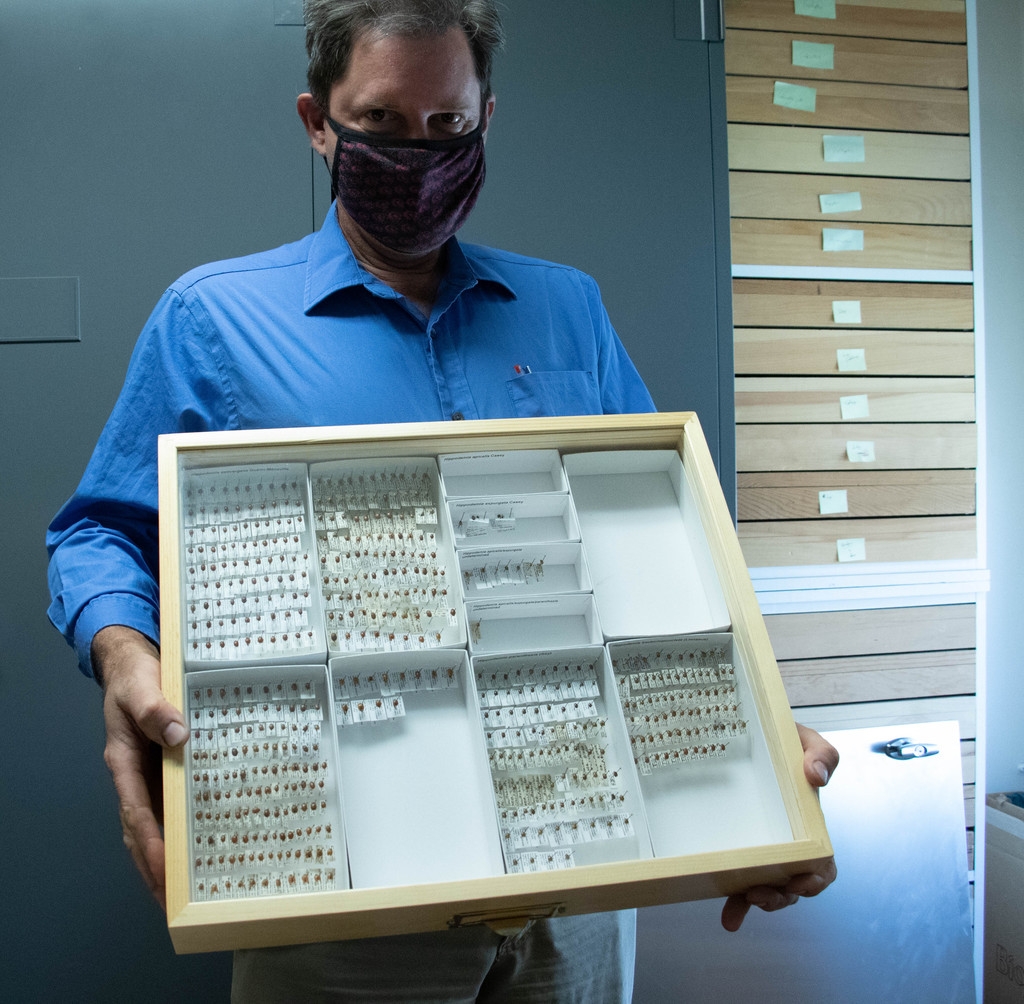CSC houses extensive invertebrate collection

CHADRON – Chadron State College students benefit from an extensive invertebrate collection. It contains twice as many specimens of lady beetles and more diversity overall than any other higher education collection in Nebraska, according to Dr. Matt Brust, professor. The CSC collection has about 1,900 lady beetle specimens representing more than 30 species and about 7,300 grasshoppers representing 120 species.
For a few insect species such as the sagebrush buck moth, Hermia underwing moth, fruit-piercing moth, and boreal grasshopper, the only specimens ever verifiably collected in Nebraska are in the CSC collection because Brust is the only person to have collected them.
Brust’s experience and expertise have helped him develop a nose for finding rare species.
“Once you learn about a species and what kind of environments it likes, then you can look for it in similar places,” Brust said. “I analyze online satellite imagery to find potential sites with habitats that might support rare species.”
The approximate 2,000-plus butterflies and moths in the collection are not yet inventoried, according to Brust.
Brust said there are two main reasons specimens are not often on display.
“The biggest enemies of preserved specimens are, first, sunlight. Light of any kind really degrades them and fades the colors. Second, certain insects like carpet beetles eat specimens. The nice thing about the dry climate in western Nebraska is that carpet beetles aren't a huge problem like back East,” Brust said.
The pinned specimens are preserved in glass top drawers inside large, lightproof cabinets. Until the completion of the Math Science Center of Innovative Learning (COIL), the collections are housed in Brooks Hall.
“There's probably an additional five or six species of grasshopper where CSC probably has at least 70 or 80 percent of the specimens ever collected in Nebraska,” Brust said.
Brust inventoried the CSC lady beetle collection during 2019 and 2020 and transferred the information from each specimen’s label to spreadsheets. Label information includes the species, date of collection, name of who collected it, location, and in some cases, GPS coordinates.
Past CSC faculty including Doris Gates in the 1960s and Randy Lawson in the 1980s, as well as Brust are the ones responsible for building the CSC collection, according to Brust. Brust said Lawson kept a lot of bycatch, insects accidentally caught while trapping other species.
“It turns out that a lot of the bycatch was lady beetles. Randy pinned them and some of these are insanely rare now. There are types of butterflies that were fairly common in the Panhandle 40 years ago that you can’t find now,” Brust said. “Hardly anybody in the country is reporting the two spotted lady beetle. I haven't seen it in my lifetime. Yet, in our collection we have evidence they were common here and not that long ago. On the other hand, it appears that some lady beetles like the nine-spotted lady beetle, which has vanished from most of North America, is still hanging on in western Nebraska.”
In addition to the work being done by professionals, Brust is an advocate for developing citizen scientists.
“I think a lot of people are probably interested but then they hit a dead end and don't know where to look for more information. So that's the job of people like me: to provide resources to allow citizen scientists to grow and also ensure quality control,” Brust said.
One technique used to calculate the quantity of various grasshopper species in a certain ecosystem is called sweep sampling.
However, Brust said the sampling is skewed.
“We have an enormous amount of sampling in rangeland habitats but almost no sampling of wetlands, woodlands, and unique habitats like saltmarshes. So that's where I'm finding a lot of unique things that have been overlooked by others,” he said.
Related articles:
Brust helps create grasshopper app
Brust's tiger beetle research published
Brust co-authors tiger beetle field guide
Brust publishes paper about newly discovered grasshopper
—Tena L. Cook, Marketing Coordinator
Category: Campus News

